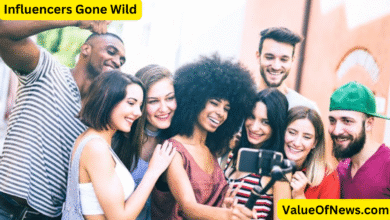Influencers Gone Wold In recent years, the rise of social media influencers has become one of the most profound shifts in the digital age. These individuals, often not bound by traditional celebrity roles, have amassed millions of followers and built powerful brands on platforms like Instagram, YouTube, TikTok, and Twitter. With this new wave of fame comes an unexpected phenomenon: influencers gone wild. But what exactly does it mean when influencers go off the rails? How does a social media figure go from being a beloved brand ambassador to a controversial figure, or even a full-on spectacle? In this article, we’ll explore the complexities surrounding influencers who lose control, examining the causes, consequences, and cultural impact of this phenomenon.
The Nature of Influence in the Digital Age
Before diving into what happens when influencers “go wild,” it’s essential to understand the scope and significance of influencers in today’s world. Social media influencers wield an unprecedented level of power over their followers. With platforms offering instant access to global audiences, an influencer’s reach can surpass that of traditional celebrities. An influencer’s ability to shape opinions, promote products, and dictate trends is immense, often rivaling or even surpassing that of more traditional forms of media.
This power is the very thing that makes Influencers Gone Wold attractive and dangerous. Social media platforms reward engagement with algorithms that amplify content, meaning that the more dramatic, engaging, or sensational a post is, the more likely it is to go viral. In a world where every post, story, or tweet can be seen by millions, the line between popularity and controversy can blur quickly.
The Lure of Fame and the Pressure to Perform
As influencers gain more followers, they often find themselves under increasing pressure to maintain their relevance. The world of social media is unforgiving, and staleness or inconsistency can quickly lead to a loss of engagement. This pressure often manifests in extreme behaviors, both positive and negative. In an effort to stay relevant, influencers may push the boundaries of what’s acceptable or even ethical. They may post increasingly provocative or controversial content, leading to backlash from their followers or the public.
However, this attention-seeking behavior can be a double-edged sword. While controversial posts can increase visibility in the short term, they can also backfire, turning an influencer’s audience against them. A fine line exists between being edgy and being reckless, and many influencers cross it in pursuit of greater fame or attention.
Influencers Gone Wild: From Controversy to Full-On Scandal
There are countless examples of influencers who have gone from adored public figures to pariahs in the blink of an eye. The rise of “cancel culture” has only intensified the consequences of an influencer misstep. One infamous example is the case of Jake Paul, a YouTuber who gained fame with his pranks and wild stunts. His antics, often crossing lines of decency, led to a public fallout and backlash. Yet, despite these controversies, Paul continued to rise in the social media ranks, illustrating how some influencers seem to thrive even in the face of scandal.
Another notable case is that of beauty mogul James Charles, whose career has been marred by a series of public feuds, accusations of inappropriate behavior, and accusations of manipulating younger followers. Despite these issues, he remains a major figure in the beauty and fashion industries. These instances suggest that, for some influencers, controversy can enhance their appeal, at least in the short term, as long as they can keep their personal brands intact.
However, not all influencers survive the fallout from their controversies. Take, for example, the downfall of YouTuber Tana Mongeau. Her rise to fame was fueled by a combination of shock value and scandalous content, but her actions eventually led to widespread criticism. Tana’s behavior, which included promoting products that weren’t ethically sourced and causing chaos at events, alienated her audience and resulted in a tarnished public image. Unlike Paul or Charles, Mongeau’s brand didn’t weather the storm, and she experienced a notable decline in popularity as a result.
The Role of Social Media in Amplifying the Wildness
Social media is the ultimate amplifier of both fame and controversy. Platforms like Instagram and TikTok thrive on virality, and nothing generates virality more effectively than conflict, drama, or spectacle. When an influencer posts something controversial, it is often shared widely, discussed in forums, and dissected by commentators. This rapid amplification can turn a small mistake into a massive public issue.
One aspect of social media that fuels this wildness is the concept of the “cancel culture” cycle. In an age where fans can quickly turn on their idols, an influencer’s reputation can be destroyed almost overnight. This often creates a “feast or famine” situation for influencers. A post that goes viral can result in increased followers and sponsorships, but a misstep can lead to an almost immediate downfall, resulting in apologies, backlash, and, in some cases, permanent damage to their brand.
But even beyond cancel culture, social media’s algorithms reward extreme content. Sensational videos, emotional outbursts, or shocking revelations often perform better than more neutral, well-thought-out posts. This means that influencers are incentivized to stir the pot, take risks, and do things that might have previously been considered unthinkable, simply to stay relevant.
The Psychology Behind Influencers Gone Wild
At the heart of the “gone wild” phenomenon is the psychology of fame. When someone becomes an influencer, they often have little understanding of the psychological toll it can take. Fame on social media is fleeting, and the desire for more likes, views, and followers can become an addictive pursuit. This constant need for validation can lead to unhealthy behaviors, including increasingly outrageous stunts or inflammatory posts.
Furthermore, the constant scrutiny faced by influencers can trigger feelings of insecurity, anxiety, and self-doubt. Many influencers are very young, and the pressure of living their lives under the public eye can sometimes push them into making rash decisions. They may try to push boundaries to prove their worth or maintain their relevance, not realizing that their actions may alienate their fanbase or damage their personal reputation.
There’s also a phenomenon known as the “echo chamber” effect on social media. Influencers often surround themselves with yes-men and sycophants, people who praise their every move and encourage them to act more outlandishly. This can isolate the influencer from reality, making them feel invincible and pushing them to take risks they might otherwise avoid. As they become more and more disconnected from their audience’s genuine feedback, their behavior can grow increasingly erratic.
The Aftermath: Rebuilding or Reinvention?
Once an influencer has “gone wild,” they are often faced with the choice of either trying to rebuild their reputation or reinvent themselves entirely. Rebuilding can be a long and arduous process, involving sincere apologies, changes in behavior, and efforts to show growth. However, in an age where the internet never forgets, it’s not always possible to erase the past.
Reinvention, on the other hand, is a more common route for influencers. They may pivot to a different form of content or enter a new industry, hoping that the controversies surrounding them will fade with time. Some influencers even embrace their wild side, building an entire brand around their rebellious or unpredictable personas. This can work for a time, but it often comes with diminishing returns as audiences grow tired of the same antics.
However, not all influencers have the luxury of choosing either route. Some have their careers permanently derailed by their actions, with brands dropping them, fans unfollowing them, and the public’s perception of them becoming irreparably damaged.
The Impact on Brands and Followers
When influencers go wild, the fallout extends beyond just the influencer. Brands that partner with influencers often find themselves caught in the crossfire. Sponsorship deals, paid promotions, and collaborations are based on the assumption that the influencer’s public image is stable and positive. When an influencer’s behavior becomes problematic, brands must often scramble to distance themselves from the situation, even if they’ve already invested significant amounts of money into the partnership.
For followers, the impact can be equally jarring. Many fans build strong emotional connections with influencers, viewing them as role models or even friends. When their favorite influencer takes a wrong turn, it can be a betrayal, leading to disillusionment and disappointment. The trust that fans have placed in these figures can be broken, resulting in lost followers and negative sentiments.
In some cases, however, fans will continue to support their favorite influencers despite their wild behavior, embracing them even more for their Influencers Gone Wold or rebellious actions. This creates a curious dynamic where some influencers find a loyal base of followers who revel in their wildness, while others see their audience shrink as they lose faith in them.
Conclusion: A Dangerous Game
The phenomenon of influencers gone wild is a complex and multifaceted issue that reflects the unpredictable nature of fame in the digital age. While it’s tempting to view these incidents as mere antics or attention-seeking behavior, they highlight deeper societal shifts in the way we consume media and interact with public figures. Influencers are no longer just content creators—they are brands, celebrities, and icons who live in the limelight, constantly walking a fine line between success and scandal.






